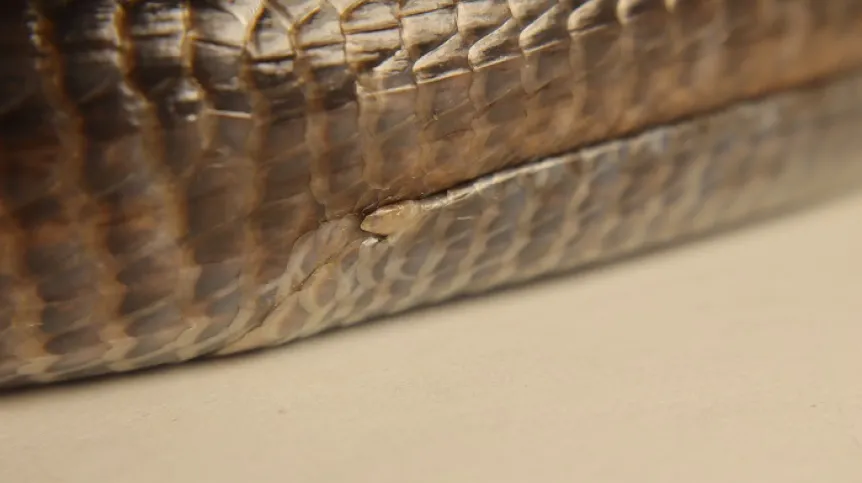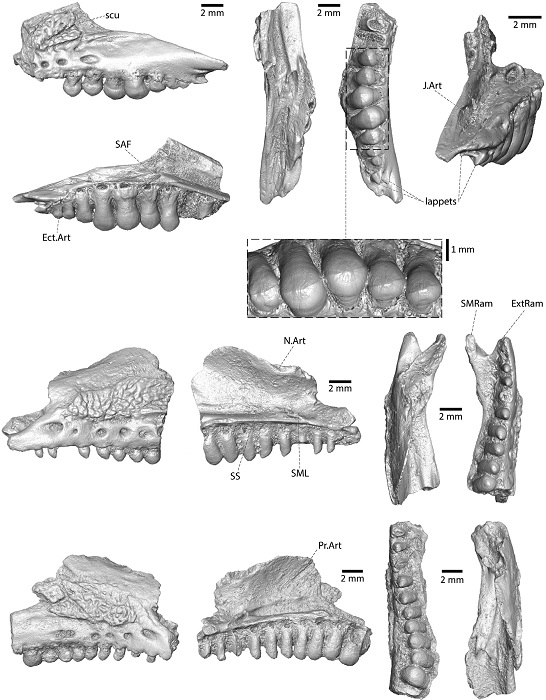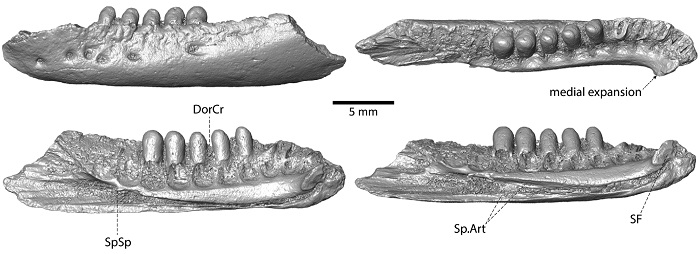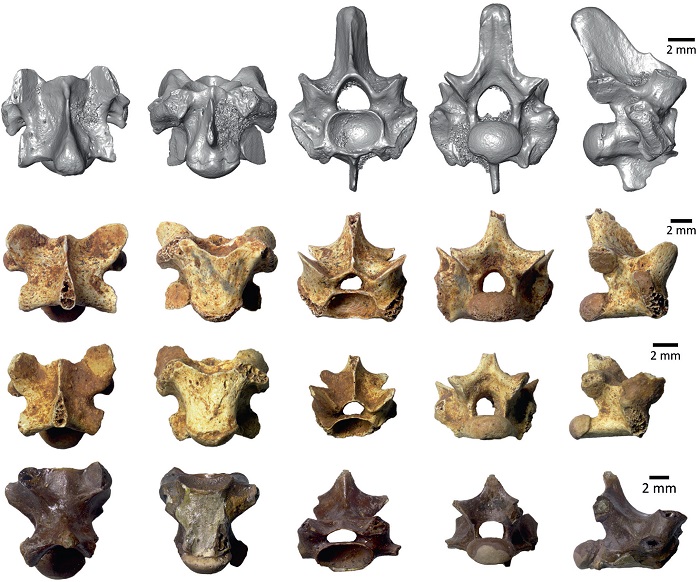
The legless lizard Pseudopus pannonicus, which lived in Poland between 15 and 2 million years ago, could have been over 2 m long.
Palaeontologists, including researchers from the Polish Academy of Sciences, have shown that this is the largest known representative of the slowworm family.
What's more, both the oldest and the youngest known specimen of this extinct species - once widespread in Europe - come from Polish palaeontological sites.

Fig. 1 - Upper jaws of Pseudopus pannonicus from the Rębielice Królewskie I site (approx. 3 million years ago). Specimens from the Herpetology and Palaeoherpetology Collection of the Institute of Systematics and Evolution of Animals of the Polish Academy of Sciences in Kraków
The lizard Pseudopus pannonicus belonged to the slowworms (family of lizards Anguidae) and was a close relative of the currently living sheltopusik (Pseudopus apodus).
'This contemporary species reaches a total length of over 130 cm, making it the largest lizard currently living in Europe. However, Pseudopus pannonicus was much larger and reached truly impressive dimensions for a lizard, exceeding 2 m in length. Apart from the difference in size, it probably looked very similar and also lacked limbs', says Dr. Georgios Georgalis from the Institute of Systematics and Evolution of Animals at the Polish Academy of Sciences in Kraków, co-author of a publication on this subject, which has just been published in The Anatomical Record.
The palaeontologist adds that it was a fairly widespread animal in Europe, constituting an important component of many ecosystems, also in the lands of today's Poland. Pseudopus pannonicus became completely extinct in the early Pleistocene (about 2 million years ago), a time coinciding with a colder climate and major environmental and climatic changes.

Fig. 2 - Parietal (i.e. roof bone of the skull) of Pseudopus pannonicus from the Przeworno site (approx. 15 million years ago). It is the oldest known fossil of this species in the world. Specimen from the Herpetology and Palaeoherpetology Collection of the Institute of Systematics and Evolution of Animals of the Polish Academy of Sciences in Kraków
Pseudopus pannonicus was first described in 1911, but only in recent years has more information about its anatomy appeared. This time, the researchers took a closer look at Pseudopus pannonicus fossils from Poland (most of them) and Hungary.
'We examined and described new, abundant fossil material of Pseudopus pannonicus from Poland, including several nicely preserved skull parts. These new Polish specimens shed important light on our knowledge of this species, revealing previously unknown anatomical features of the skull and vertebrae', says Georgalis.
The Polish research material comes from several locations, covering different periods. 'We have Przeworno in the Lower Silesia (approx. 15 million years ago), the Węże I site in the Łódź Voivodeship (approx. 4 million years ago), Rębielice Królewskie in the north of Silesia and the Węże II site (approx. 3 million years ago), up to the Kadzielnia site in the Świętokrzyskie Voivodeship (approx. 2 million years ago)', Georgalis says.

Fig. 3 - Lower jaw of Pseudopus pannonicus from the Rębielice Królewskie I site (approx. 3 million years ago). Specimen from the Herpetology and Palaeoherpetology Collection of the Institute of Systematics and Evolution of Animals of the Polish Academy of Sciences in Kraków
The researchers also used specimens described earlier, several decades ago. 'However, we used new technologies here, in particular microcomputer tomography (μCT), which allowed us to thoroughly examine the fossils and study their internal anatomy. Moreover, thanks to this technology, we created high-resolution 3D models of the most important fossil specimens from Poland', Georgalis continues.
Most of the fossil specimens belong to the Herpetology and Palaeoherpetology Collection of the Institute of Systematics and Evolution of Animals of the Polish Academy of Sciences in Kraków, and some to the Institute of Palaeobiology of the Polish Academy of Sciences in Warsaw and the Museum of the Earth of the Polish Academy of Sciences in Warsaw.
'All this new anatomical and taxonomic information from Polish fossil material will now enable a more precise identification of new Pseudopus pannonicus fossil finds from all over Europe. Moreover, the fact that both the oldest and the youngest Pseudopus pannonicus remains come from Poland provides new implications on the origin, but also on the causes of the species' extinction, and in general on the evolution of the emblematic genus Pseudopus, which remains the largest lizard in Europe to this day', says Georgalis.

Fig. 4 - Vertebrae of Pseudopus pannonicus from the sites Rębielice Królewskie I (approx. 3 million years ago), Kadzielnia (approx. 2 million years ago) and Węże I (approx. 4 million years ago). Specimens from the Herpetology and Palaeoherpetology Collection of the Institute of Systematics and Evolution of Animals of the Polish Academy of Sciences in Kraków
The research was conducted in collaboration with palaeontologists from Comenius University in Bratislava (Erwan Loréal and Andrej Čerňanský), as part of the project 'New fossils provide novel insights into the evolution of Cenozoic lizards and snakes from Europe and the circum-Mediterranean region', financed by the Polish National Science Centre. (PAP)
PAP - Science in Poland, Agnieszka Kliks-Pudlik
akp/ bar/ kap/
tr. RL













